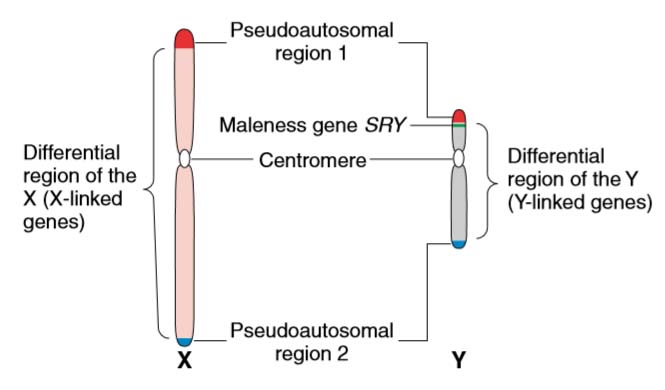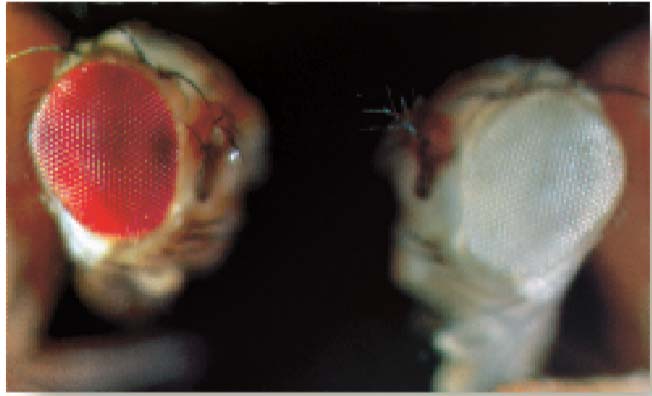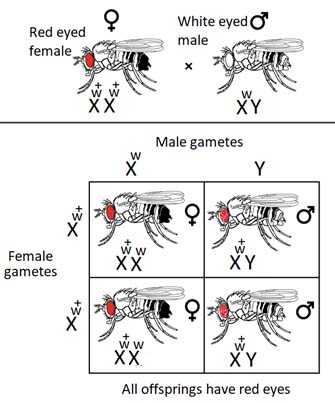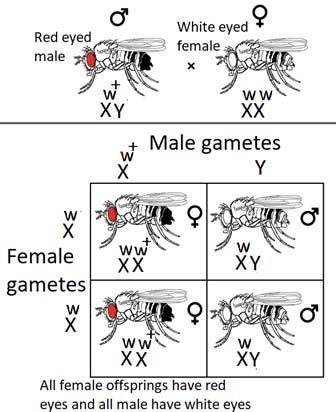The X and Y chromosomes are divided into two regions homologous and differential regions.
In humans the homologous regions contain DNA sequences that are substantially similar on both sex chromosomes.
The differential regions contain genes that have no counterparts on the other sex chromosome. Hence in males these genes in the differential regions are thus said to be hemizygous (“half zygous”).
The X chromosome contains many hundreds of genes; most of these genes are not involved in sexual function, and most have no counterparts on the Y.
The Y chromosome contains only a few dozen genes. Some of these genes have counterparts on the X, but some do not. Most of the latter type are involved in male sexual function. One of these genes, SRY, determines maleness itself. Several other genes are specific for sperm production in males.
Genes in the differential region of the X show an inheritance pattern called X linkage; those in the differential region of the Y show Y linkage. In general, genes on the differential regions are said to show sex linkage. A gene that is sex-linked shows patterns of inheritance related to sex.
This pattern contrasts with the inheritance patterns of genes on the autosomes, which are not connected to sex. In autosomal inheritance, male and female progeny show inherited phenotypes in exactly the same proportions, as typified by Mendel’s results (for example,both sexes of an F2 might show a 3:1 ratio). In contrast, crosses performed to track the inheritance of genes on the sex chromosomes often produce male and female progeny that show different phenotypic ratios. In fact, for studies of genes of unknown chromosomal location, this pattern is a diagnostic of location on the sex chromosomes.
Pseudoautosomal regions
The human X and Y chromosomes have two homologous regions, one at each end. In being homologous these regions are autosomal-like,so they are called pseudoautosomal regions 1 and 2. One or both of these regions pair during meiosis, and undergo crossing over. In this way, the X and the Y can act as a pair and segregate into equal numbers of sperm.
The genes that are located on sex chromosomes are called as sex linked genes and this phenomenon is called as sex linkage

Fig: Differential and pairing regions of human sex chromosomes. The regions were located by observing where the chromosomes paired up in meiosis and where they did not.
Discovery
The inheritance patterns of genes on the sex chromosomes are different from those of autosomal genes.
These sex chromosome inheritance patterns were first investigated in the fruit fly Drosophila melanogaster.
Fruit flies have three pairs of autosomes plus a pair of sex chromosomes again referred to as X and Y. As in mammals, Drosophila females have the constitution XX and males are XY. However, the mechanism of sex determination in Drosophila differs from that in mammals. In Drosophila, the number of X chromosomes determines sex: two X’s result in a female and one X results in a male.
In mammals, the presence of the Y determines maleness and the absence of a Y determines femaleness.
- H. Morgan observed that the normal eye color of fruit-fly is bright red (wild type). He also observed a white-eyed male fly as mutant type. When he crossed this white-eyed male with a normal red-eyed female. All individuals of F1 were red eyed. Its means red eye is dominant over white eye.
 Fig: Red eyes and white eyes in Drosophilla
Fig: Red eyes and white eyes in Drosophilla
Then T.H. Morgan allowed further to mate the male and female members of the F1 generation to produce F2 generation. In the F2 generation, there were both red-eyed as well as white-eyed in the ratio of 3:1. This was all according to Mendelian ratio. However, there was a peculiarity in the results. All the flies that had white eyes were male, while all female flies had red eyes. He concluded that inheritance of eye colour is related with the sex of offspring. In other words, he thought that the gene for eye colour may be located on the sex-chromosomes.

Cross fertilization between male Drosophilla white eyed and female red eyed
In the light of above-mentioned facts and the results of the cross between a white-eyed male and a red-eyed female fly, Morgan proposed the following hypothesis:
HYPOTHESIS
The alleles for eye-colour in Drosophila are located only on the X-chromosomes and there is no allele for the eye-colour on the Y-chromosomes.
TEST CROSS
He mated the original white-eyed male (XwY) with a red-eyed female (Xw+Xw) from the F1 generation. The result of this cross showed that the half of the females had white eyes (XwXw) and the other half had red eyes (XwXw+). Similarly, half of the males were red-eyed (Xw+Y), and another half were white-eyed (XwY).
RECIPROCAL CROSS
After obtaining white-eyed female Morgan further confirmed his hypothesis by another test cross. He mated white-eyed female (XwXw) with a red-eyed male (Xw+Y). In F1, all the females were red-eyed (Xw+Xw) while all the males were white-eyed (XwY). In F2 generation half the males and females were red-eyed, while other half were white-eyed.

Fig Reciprocal cross( Female with white eyes crossed to male with red eyes and in F1 all females were red eyed and all males were white eyed)
CONCLUSION
From these cross it was concluded:
- Certain traits are controlled by genes lying on sex chromosomes. Such traits are called sex-linked traits.
- Sex linked traits are determined by genes found on the X chromosome, but not on Y-chromosome.
- These crosses provided a strong confirmation of Sutton’s hypothesis that genes are located on chromosomes.